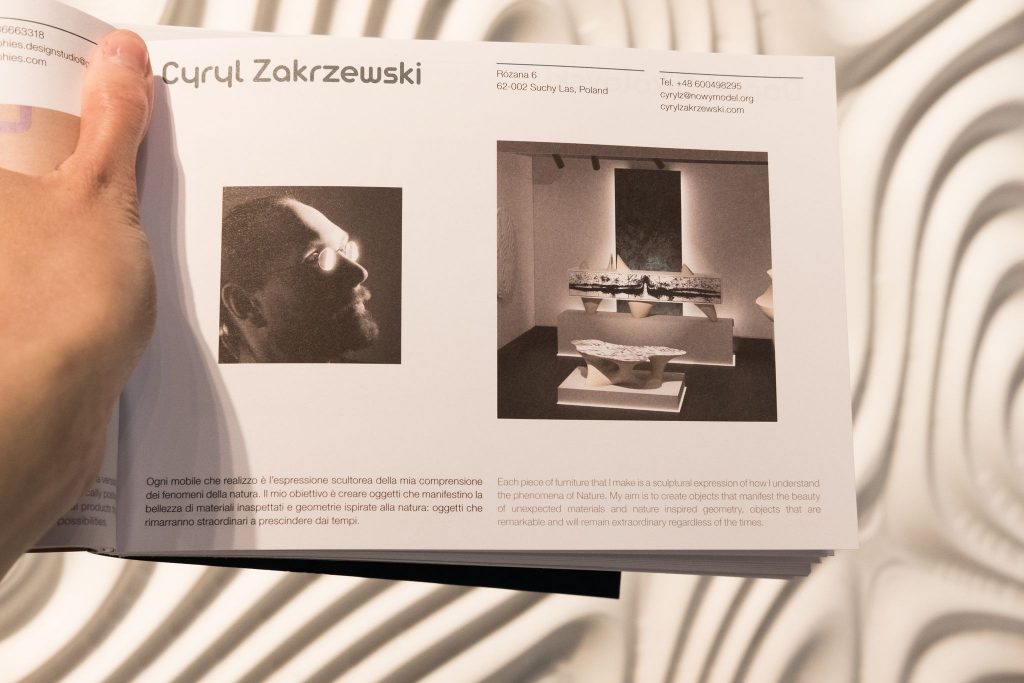

Polish sculptor and designer Cyryl Zakrzewski conquering the world's Salons with his bionic furniture. His latest collection premiering in Milan, "the Continuum", proves that even a piece of trash can turn into treasure.
The 60th anniversary edition of Salone del Mobile.Milana, the largest furniture and intertior design fair is coming back to its original formula in its heated fight for the pole position in setting the world's trends. The fair, originally planned for last year, due to pandemie disturbances has been postponed to take place at the beginning of June under a telltale slogan of a new beginning,
As every year, there are thousands of exhibitors and those waiting for their work
and none of them argue with the statement that our planet is undergoing a crisis caused by the economic overexploitation. The words ecology, conscious design, responsibility and the future of the planet have long since left research laboratories and discussion panels, and the awareness of excess and exploitation affects modern production, not just marketing.
Plastic is fantastic.
The remedy for some contemporary problems turns out to be the same thing that contributes to our impending doom - plastic. From a scorned, despised materiał, plastic turns into a decorative alternative to the apocalypse of civilization, and at the same time allows you to break routine and boredom.
Sounds incredible?
The "Continuum" collection, utilizing plastics for the first time and gaining praise at the Salone del Mobile is the proof of that. During previous fairs, Cyryl Zakrzewski drew the attention of critics and even the daily media, who noted his phenomenal "Dune" in their reports. "Dune" - a chair, or rather an organie sculpture with the function of a seat, in it's name and form alludes to sand dunes, but also refers to a much wider, iconic landscape. The reference to the famous science fiction prose defines the futuristic perspective that the young sculptor from Poznań sets with his designs. His piece is made of natural birch plywood, hand-finished, soaked with natural oil, is like a soft-shaped sculpture, although it also perfectly fulfills its function - a seat, a modern-day throne. lt is both a piece of interior design and a symbol of status and luxury of the person who sits on it, but also, not less importantly, an object that perfectly functions in a gallery environment. Cyryl Zakrzewski's designs have been called 'bionic design' - their form referring to nature in the micro and macro scale, as well as skilful use of the latest technology, enabling the perfect reproduction of the illusion of natural shape. However, only recently, after beginning his cooperation with Boomplastik, there has been a breakthrough in his design.Thanks to a broader, mare conscious view of aur civilization's self-destruction, these furniture designs become an excellent, original and eloquent response to the present day.
The innovative "Dune" chair has found a worthy continuation in the latest collection of furniture presented in Milan.
Bath "Nexus" and "Noise", which make up the "Continuum" collection, are the result of Cyryl Zakrzewski's fascination with nature, but also a visible testimony of his knowledge and, most importantly, application, of the latest technological achievements. Technological support and long-term cooperation with the NowyModel Foundation are also important here, this partnership allowed Cyril Zakrzewski to obtain unexpected creative possibilities. The poured, multicolored, recycled plastic allows him to create surfaces with any pattern -this time his choice of motif was influenced by computer algorithmic records, be it particie vibrations or sound waves. The original selection of a fragment from the computer record is arbitrary, but there's no denying that it's visually attractive. Surprising, puzzling and sometimes delightful. Surprisingly "natural" in its plastic artificiality.
You could say that it is a showy, nice superficial effect, but it ceases to be banał when we notice the precision with which it was chosen, and - thanks to the power of creation - metaphorically turned from waste to gold.
A piece of garbage, properly processed, gains a decorative function, and although it is a rather expensive process at the moment, it opens up unlimited possibilities for materiał and aesthetic exploitation in the future. Bath "Noise" and "Nexus", despite their simple, traditional shapes, are both decorative and modern. The plastic plates used are durable, comfortable and decorated with a graphic or relief pattern. This contemporary ornament has been hand-poured, like in the process of drawing, and the surface has been manually modelled, akin to a sculpture. Then, in a suitable new technology based on pressing and melting, the powder was turned into a hard and durable furniture board.
Is it ecological?
I don't know, but the technology allows us to give a second, attractive life to a piece of garbage. The rest depends on the creativity of the creator.
Reszta zależy od inwencji twórcy. Co prawda nie następuje tu cudowne przeistoczenie, stuprocentowe wtórne wykorzystanie, lub biodegradacja. Ale dzięki pomysłowi projektanta, z odpadu plastik zmienia się w wysublimowany wizualnie i ekskluzywny przedmiot. I co najważniejsze zatrzymany zostaje proces
„zaśmiecania”. I choć kontekst ekologiczny może nie mieć znaczenia w ocenie estetycznej walorów mebli, to pozostaje cenną wartością dodaną do intrygujących, futurystycznych kształtów mebli Cyryla Zakrzewskiego.
Agata Saraczyńska







Fot. Agnieszka Kula


